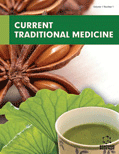Abstract
Background: Euterpe oleracea Mart (açaí) is traditionally used as antidiarrheal, kidney and liver infections and as antimalarial.
Methods: A review on Euterpe oleracea Mart was carried out in different databases, such as PubMed, Medline, Scielo, Herbal Medicine, as well as dissertations, theses, and books.
Results: The literature shows the anticancer potential of açaí in different e cancer models. Regarding phytochemical composition, the literature shows greater amount of polyphenols, especially anthocyanins.
Conclusions: The different uses of Euterpe oleracea Mart have been demonstrated by pharmacological and phytochemical studies, with the great amount of polyphenols, found in açaí, being pointed out as the main responsible for its anticancer activity.
Keywords: Euterpe oleracea Mart, Traditional use, Phytochemistry, Pharmacology, Anticancer activity
Graphical Abstract
Current Traditional Medicine
Title:Traditional Uses, Phytochemistry, Pharmacology and Anticancer Activity of Açaí (Euterpe oleracea Mart): A Narrative Review
Volume: 7 Issue: 5
Author(s): Marcos Antonio Custódio Neto da Silva*, Maria do Desterro Soares Brandão Nascimento and João Ernesto de Carvalho
Affiliation:
- School of Medical Sciences, State University of Campinas (FCM-UNICAMP), Graduate Program in Medical Clinic, Campinas, São Paulo,Brazil
Keywords: Euterpe oleracea Mart, Traditional use, Phytochemistry, Pharmacology, Anticancer activity
Abstract: Background: Euterpe oleracea Mart (açaí) is traditionally used as antidiarrheal, kidney and liver infections and as antimalarial.
Methods: A review on Euterpe oleracea Mart was carried out in different databases, such as PubMed, Medline, Scielo, Herbal Medicine, as well as dissertations, theses, and books.
Results: The literature shows the anticancer potential of açaí in different e cancer models. Regarding phytochemical composition, the literature shows greater amount of polyphenols, especially anthocyanins.
Conclusions: The different uses of Euterpe oleracea Mart have been demonstrated by pharmacological and phytochemical studies, with the great amount of polyphenols, found in açaí, being pointed out as the main responsible for its anticancer activity.
Export Options
About this article
Cite this article as:
da Silva Antonio Custódio Neto Marcos *, do Desterro Soares Brandão Nascimento Maria and de Carvalho Ernesto João , Traditional Uses, Phytochemistry, Pharmacology and Anticancer Activity of Açaí (Euterpe oleracea Mart): A Narrative Review, Current Traditional Medicine 2021; 7 (5) : e070520181766 . https://dx.doi.org/10.2174/2215083806999200508081308
| DOI https://dx.doi.org/10.2174/2215083806999200508081308 |
Print ISSN 2215-0838 |
| Publisher Name Bentham Science Publisher |
Online ISSN 2215-0846 |
 14
14
- Author Guidelines
- Bentham Author Support Services (BASS)
- Graphical Abstracts
- Fabricating and Stating False Information
- Research Misconduct
- Post Publication Discussions and Corrections
- Publishing Ethics and Rectitude
- Increase Visibility of Your Article
- Archiving Policies
- Peer Review Workflow
- Order Your Article Before Print
- Promote Your Article
- Manuscript Transfer Facility
- Editorial Policies
- Allegations from Whistleblowers
- Announcements
Related Articles
-
Sumoylation as an Emerging Target in Therapeutics against Cancer
Current Pharmaceutical Design Ultrasound Assisted Synthesis of 3-(het)aryl Isocoumarin Derivatives and their in vitro Pharmacological Evaluation
Mini-Reviews in Medicinal Chemistry Imaging in Inflammatory Bowel Disease Mucosal Healing in Ulcerative Colitis: Relevance for Clinical Outcomes
Current Drug Targets The Yin and Yang of microRNA Assay Methods
MicroRNA Potential of Modulating Wnt Signaling Pathway Toward the Development of Bone Anabolic Agent
Current Molecular Pharmacology Editorial [Hot Topic: Drug Delivery Strategies in Targeting Cancer:Current Concepts and Future Developments (Guest Editor: Jose L. Arias)]
Current Drug Targets Mesenchymal Stem Cells, Immune Cells and Tumor Cells Crosstalk: A Sinister Triangle in the Tumor Microenvironment
Current Stem Cell Research & Therapy Low-Dose Aspirin-Associated Upper and Mid Gastrointestinal Tract Damage and Gene Polymorphism
Current Pharmaceutical Design Meet Our Editorial Board Member
Anti-Cancer Agents in Medicinal Chemistry Influence of ESR1 Variants on Clinical Characteristics and Fibromyalgia Syndrome in Turkish Women
Endocrine, Metabolic & Immune Disorders - Drug Targets Enhanced Expression of miR-199b-5p Promotes Proliferation of Pancreatic β-Cells by Down-Regulation of MLK3
MicroRNA The Role of XRCC4 in Carcinogenesis and Anticancer Drug Discovery
Recent Patents on Anti-Cancer Drug Discovery Plant Coumestans: Recent Advances and Future Perspectives in Cancer Therapy
Anti-Cancer Agents in Medicinal Chemistry Improvement of Tumor Localization of Photosensitizers for Photodynamic Therapy and Its Application for Tumor Diagnosis
Current Topics in Medicinal Chemistry Drug Repurposing: Translational Pharmacology, Chemistry, Computers and the Clinic
Current Topics in Medicinal Chemistry Is High Oral Dose L-arginine Intake Effective in Leukoaraiosis? Preliminary Data, Study Protocol and Expert’s Opinion
Current Aging Science Oxidative Stress and Cancer: The Role of Nrf2
Current Cancer Drug Targets Solanum nigrum Anticancer Effect Through Epigenetic Modulations in Breast Cancer Cell Lines
Current Cancer Therapy Reviews Microbiology of the Human Intestinal Tract and Approaches for Its Dietary Modulation
Current Pharmaceutical Design Clinical Utility of Combined 18F-Fluoro-2-deoxyglucose Positron Emission Tomography – Computed Tomography in the Evaluation of Gastrointestinal Malignancies
Current Medical Imaging



























